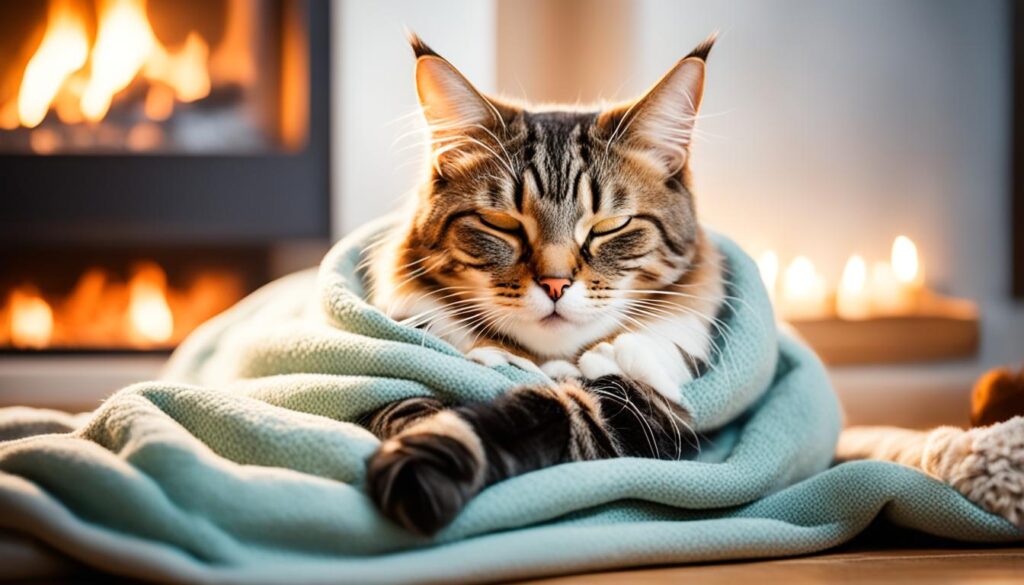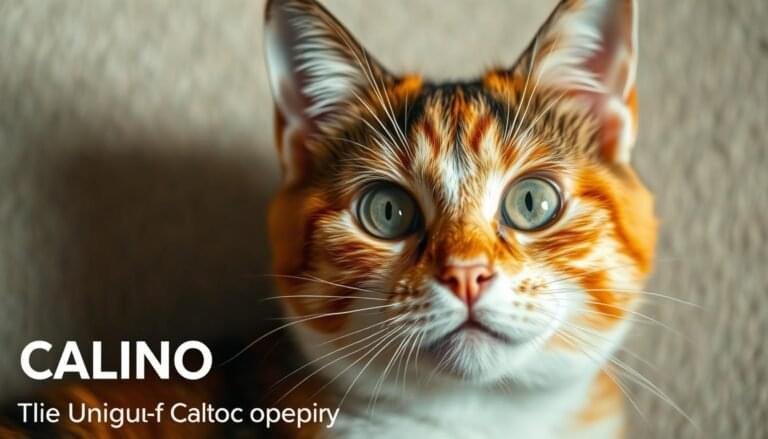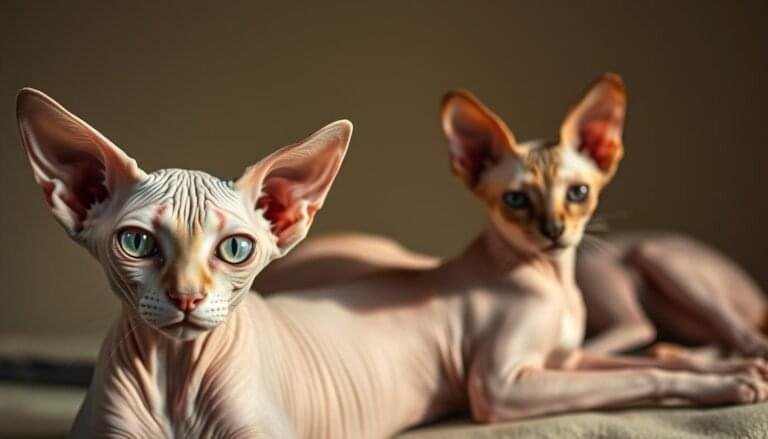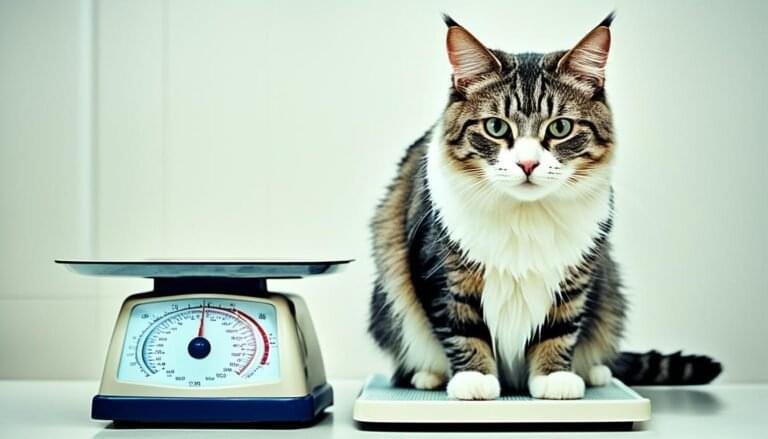Cats’ Biting Blanket and Kneading: Did you know that 90% of cats exhibit kneading behavior at some point in their lives? Whether it’s on a soft blanket, your lap, or even the couch cushions, this instinctive and sometimes puzzling behavior is a common feline habit. But why do cats knead and sometimes accompany it with biting, purring, or even drooling?
In this article, we will delve into the fascinating world of cat behavior to uncover the reasons behind kneading and biting. From understanding the instinctual origins of this behavior to learning how to redirect it, we will provide you with valuable pet care tips to better understand your furry friend.
Cats Biting Blanket and Kneading Key Takeaways:
- Kneading is a normal and instinctive behavior in cats, with 90% of them engaging in this behavior at some point.
- Cats knead to find comfort, mimic nursing behavior from kittenhood, and mark their territory.
- Redirecting a cat’s kneading and biting behavior can be done through alternative objects, such as special blankets or toys.
- If a cat’s kneading and biting become problematic or cause discomfort, techniques like distraction or gentle removal can be used.
- Cat kneading and biting can also be a form of bonding and a way for cats to communicate affection and trust.
What Is Kneading?
Kneading is a natural behavior displayed by cats, characterized by the rhythmic pawing motion they make, typically on soft surfaces like blankets. During kneading, cats alternate pushing each forelimb paw into the surface and then pulling it back. This behavior is often referred to as “making biscuits” due to the similarity in motion to the kneading of dough.
Kneading serves various purposes for cats and is influenced by their feline instincts. Let’s take a closer look at the reasons behind this fascinating behavior:
Comfort and Relaxation
Kneading is a comforting behavior for cats, and it helps them relax and find a sense of security. The rhythmic motion of kneading mimics the behavior kittens exhibit while nursing, triggering memories of their early bonding experiences with their mother and littermates.
During kneading, cats may also enter a drowsy state, purr, or drool, which further denotes their contentment and relaxation.
Instinctive Behavior
Cats’ instinct to knead originates from their days as kittens. Kneading stimulates the flow of milk from their mother’s teats, promoting their nourishment. As adult cats, they may continue this behavior as a sign of comfort and reassurance.
Additionally, kneading is a way for cats to mark their territory. Cats have scent glands located in their paws, and by kneading on a surface, they deposit their personal scent, signaling ownership and familiarity.
Reasons Behind Cat Kneading
| Reasons | Description |
|---|---|
| Comfort and Relaxation | Kneading helps cats find comfort and relaxation, as it mimics nursing behavior and triggers positive memories. |
| Instinctive Behavior | Adult cats retain their kitten instinct to knead, which serves as a source of comfort and reassurance. |
| Territory Marking | Kneading allows cats to leave their scent through the glands on their paws, marking their territory. |
Reasons for Kneading and Biting
Cats knead and bite blankets for various reasons. One common reason is the nursing instinct from kittenhood. Kneading and biting stimulate milk production in kittens, and adult cats may continue this behavior for comfort and relaxation.
Kneading can also be a way for cats to mark their territory, as they have scent glands in their paws. Additionally, some cats may knead and bite during play as a way to mimic their hunting instincts.
| Reasons for Kneading and Biting | Explanation |
|---|---|
| Nursing Instinct | Stimulates milk production in kittens and provides comfort and relaxation for adult cats. |
| Territorial marking | Cats mark their territory by leaving their scent on the blankets through kneading. |
| Mimicking hunting instincts | Kneading and biting may be a way for cats to mimic their natural hunting behaviors during play. |
Kneading and biting behaviors in cats serve a combination of physiological and instinctual purposes. By understanding these reasons, cat owners can better appreciate and respond to their feline companions’ behaviors.
Bed Making
One fascinating theory suggests that the kneading behavior in cats may stem from their ancestors’ need to create a comfortable sleeping spot in the wild. It is believed that cats engage in kneading before settling down to sleep as a way to make the surface softer and more comfortable.
While the exact reason behind this bed-making behavior is not fully understood, it is thought to be linked to the pleasure and comfort that cats experience. Kneading allows them to create a cozy and inviting space for themselves, ensuring a restful sleep.
Image:
Theories on Bed Making Behavior
There are several theories that attempt to explain why cats engage in bed making behavior:
- Territory marking: Kneading on a particular spot may serve as a way for cats to mark it as their territory, ensuring that other cats know to keep their distance.
- Comfort and relaxation: By kneading and creating a softer surface, cats can experience greater comfort and relaxation, leading to more restful sleep.
- Mimicking wild instincts: The act of bed making may be a residual behavior from when cats had to create their own sleeping spots in the wild, allowing them to better camouflage themselves and feel secure.
While these theories provide potential explanations, the exact reasons for cats engaging in bed making behavior remain a topic of ongoing research and discussion.
| Reasons for Bed Making | Explanation |
|---|---|
| Territory marking | Cats may knead to claim a specific area as their own, ensuring territorial boundaries. |
| Comfort and relaxation | Creating a softer surface through kneading helps cats achieve a higher level of comfort and relaxation during sleep. |
| Mimicking wild instincts | Bed making behavior may be an instinctual remnant of wild cats creating safe and secure sleeping spots. |
Playing

When it comes to cat behavior, kneading can also be linked to play. Cats have a natural instinct for hunting, and the rhythmic motion of kneading can resemble the way they grab and bite at their prey during play sessions. This behavior allows them to mimic their hunting instincts and engage in a playful activity that satisfies their natural feline instincts.
If you notice your cat biting at inappropriate things or during cuddling sessions, it is important to redirect their behavior towards more appropriate outlets. Providing your cat with plenty of cat toys and mental stimulation can help redirect their focus and prevent them from biting or kneading inappropriately.
| Benefits of Play for Cats: |
|---|
| 1. Mental Stimulation |
| 2. Physical Exercise |
| 3. Stress Relief |
| 4. Bonding Opportunity |
Engaging in play with your cat using interactive toys and games not only helps redirect their biting behavior but also provides numerous benefits for their overall well-being. Playtime helps stimulate their mind, keeps them physically active, reduces stress, and strengthens the bond between you and your feline companion.
Here are a few popular cat toys that can keep your furry friend happily engaged:
- Interactive Wand Toys: These toys allow you to mimic prey movements and encourage your cat to chase, pounce, and engage in a play session.
- Puzzle Toys: These toys challenge your cat’s problem-solving skills and keep them mentally stimulated while they work to retrieve treats or solve puzzles.
- Feather Toys: Cats are instinctively attracted to feathers, and feather toys provide an opportunity for them to engage in their natural hunting behavior.
- Ball Toys: Rolling or bouncing toys can be great for interactive play sessions as they encourage chasing and swatting.
By offering a variety of toys that cater to your cat’s hunting instincts and providing regular play sessions, you can help redirect their biting behavior towards more appropriate play activities, ensuring a happy and fulfilled feline friend.
Kneading and Biting Hurt! How to Stop It?
While kneading and biting are natural behaviors for cats, they can sometimes cause discomfort or even pain for the recipient. If your cat tends to knead and bite on you, there are several strategies you can try to redirect this behavior and prevent any unwanted pain or discomfort.
To minimize the impact of your cat’s kneading and biting, you can place a thick blanket between yourself and the cat. This acts as a cushion, reducing the pressure of their paws and teeth on your skin. It provides a barrier that still allows your cat to engage in their natural behavior while protecting you from any potential pain.
Another effective approach is to redirect your cat’s behavior by providing them with a special blanket or item that carries your scent. Choose a blanket or small pillow, for example, that you don’t mind your cat kneading and biting. This item will serve as a replacement for your body and can help satisfy your cat’s instinctual needs. The familiar scent will attract your cat and make them more likely to choose this alternative object to knead and bite.
In some cases, using pheromone sprays can also be beneficial. These sprays are designed to mimic the natural pheromones that cats release when they feel calm and secure. By spraying the replacement item with the pheromone spray, you can make it even more appealing to your cat and increase their likelihood of using it for kneading and biting.
If you want to discourage your cat from kneading and biting altogether, gently remove them from the situation whenever they start the behavior. This can be done by picking them up and placing them in a different location. Additionally, providing plenty of interactive cat toys can help redirect their energy and focus, giving them an alternative outlet for their natural instincts.
Remember, it’s important to avoid shouting or scaring your cat as a means of stopping their kneading and biting behavior. This can cause stress or fear, which may exacerbate the very behavior you’re trying to address. Instead, use positive reinforcement techniques and reward your cat when they engage in appropriate behaviors, such as playing with their toys or using the designated kneading and biting item.
By implementing these strategies, you can help manage and redirect your cat’s kneading and biting behavior in a way that is both safe and enjoyable for everyone involved.
Cat Kneading as a Form of Bonding

Cats are known for their unique behaviors, and one fascinating behavior that many cat owners observe is kneading. Kneading is when a cat rhythmically pushes their paws into a soft surface, alternating between their left and right paws. While the reasons behind this behavior can vary, one common explanation is that cat kneading is a form of bonding.
When a cat kneads, it often reminds them of the comfort and security they experienced during their nursing period as kittens. The motion of kneading against a soft surface resembles the actions they performed while nursing to stimulate the mother cat’s milk production. This association with a time of nurturing and contentment creates a sense of comfort for the cat.
Furthermore, cat kneading releases happy pheromones from the scent glands located in their feet. These pheromones contribute to a sense of relaxation and pleasure, further strengthening the bond between cats and their owners. So, if your cat kneads and bites on your lap or clothing, it is a sign of affection and trust.
Understanding and appreciating cat kneading as a form of bonding can deepen the cat-owner relationship. It allows us to recognize the efforts our feline companions make to show their affection and seek comfort in our presence. Next time your cat starts to knead, embrace the moment and enjoy the special connection you share.
Cat Kneading and Blanket Biting as a Comforting Behavior
Kneading and biting blankets is a comforting behavior for cats. Even though they no longer need to stimulate milk production as adults, the motions of kneading and biting remind them of comfort, safety, and warmth. Drooling during kneading is also common, as the salivary glands anticipate milk. Cats are most likely to perform kneading behavior when they feel secure and comforted.
When cats knead and bite blankets, it is a soothing behavior that harkens back to their early days when they relied on their mother’s milk for nourishment and warmth. The repetitive motion of kneading and the sensation of biting provides a sense of comfort and relaxation for cats.
During this behavior, cats often enter a drowsy state, purring softly as they engage in the rhythmic pawing motion. The act of kneading and biting blankets can be seen as a form of self-soothing and a way to find comfort and contentment. It is a behavior that brings them a sense of security and relaxation.
The image below captures the serene and tranquil nature of cats engaging in this soothing behavior:
A cat kneading a soft blanket
As you can see, the cat is fully immersed in the moment, finding solace and peace through the act of kneading. The gentle, rhythmic pawing motion offers a release of tension and a moment of feline tranquility.
Next, we’ll explore how kneading and biting behavior serves another purpose for cats – territory marking.
Cat Kneading and Biting as Territory Marking
When cats knead on a surface, they are not only seeking comfort, but they are also engaging in a behavior called territory marking. Cats have scent glands in their paws, and the act of kneading releases these scent pheromones onto the surface. This is a way for cats to communicate and claim ownership of their surroundings, particularly in multi-cat households.
In households with multiple cats, each cat may have their favorite items that they want to mark as their territory. By kneading and leaving their scent, cats are communicating to other cats to stay away from their claimed space. This territorial behavior is instinctive and serves as a way for cats to establish their dominance and maintain a sense of ownership.
Cats Kneading and Biting: Wild Instincts and Bedding
The behavior of cat kneading and biting may be rooted in the wild instincts of our feline friends. Cats’ ancestors likely engaged in these behaviors to create a softer and more comfortable place to sleep in the long grasses of their natural habitat. Although most domestic cats now knead on a specific spot rather than the surrounding area, the behavior may still be linked to the pleasure and comfort associated with creating a sleeping spot.
Cats’ wild instincts play a significant role in their behavior, even in the comfort of our homes. Understanding these instincts can help us better understand and engage with our furry companions. Let’s explore this fascinating aspect of cat behavior further.
Conclusion
Kneading and biting behavior in cats is a natural and instinctive behavior that serves multiple purposes. It is often associated with comfort, bonding, and territory marking. Understanding the reasons behind these behaviors can help cat owners better interpret and respond to their feline companions.
If a cat’s kneading and biting behavior becomes problematic or causes discomfort, there are techniques to redirect the behavior and provide alternatives. Placing a thick blanket between the cat and yourself can help reduce the impact of biting. Introducing special blankets or items that have your scent can also provide a suitable replacement for the cat to knead and bite. Additionally, offering a variety of cat toys and mental stimulation can help redirect the behavior and fulfill their hunting instincts.
Overall, cat kneading and biting can be seen as a form of communication and expression. By learning about and embracing these behaviors, cat owners can enhance the bond with their pets while providing them with a safe, comfortable, and enriched environment.
FAQ
What is kneading?
Why do cats knead and bite blankets?
What is bed making behavior?
How does playing relate to kneading and biting behavior in cats?
What can I do to stop a cat from kneading and biting me?
Why do cats knead on their owners’ laps or clothing?
Why do cats find comfort in kneading and biting blankets?
Is there a territorial aspect to kneading and biting behavior in cats?
What is the connection between wild instincts and kneading and biting behavior?
How can I handle problematic cat kneading and biting behavior?
References
|
International Cat Association (TICA) |
|
|
The Cat Fanciers’ Association (CFA) |
|
|
World Cat Federation (WCF) |
|
|
Fédération Internationale Féline (FIFe) |








[…] that you have a better understanding of the Persian Cat breed, you can make an informed decision about whether this feline is the right fit for your home. […]
[…] unique as a breed. While they are renowned for their loyalty and protectiveness, it is important to understand that proper training and socialization are crucial in shaping their […]
[…] great companions for the right owner, but they require proper training, socialization, and care. By understanding their physical and behavioral needs, you can ensure that your Akita lives a happy, healthy, and fulfilling […]
[…] the sleep habits of big cats helps us gain insights into the natural behaviors of our domestic feline companions. While they may […]
[…] exploring the role of grooming in cat behavior and understanding the significance of licking as a form of communication, cat owners can deepen their connection with […]
[…] Understanding cat fertility and mating behavior allows cat owners to make informed decisions about breeding and reproduction. […]
[…] The exact cause of feline hyperthyroidism is unknown, but there are several theories and potential contributing factors. One theory suggests that environmental factors, such as exposure to certain chemicals or flame retardants, may play a role. Another theory implicates dietary factors, particularly high levels of iodine in the diet. There may also be a genetic predisposition, although no specific breed has been identified as being more susceptible. Further research is needed to fully understand the causes of hyperthyroidism in cats. […]
[…] understanding the concept of the kitten season and taking proactive measures to address cat overpopulation are crucial steps towards […]
[…] it comes to hypoallergenic cat breeds, it’s important to understand the allergy triggers in cats. The proteins that cause allergies are typically found in cat dander, which consists of the dead […]
[…] family and property. Early socialization is vital to develop a well-adjusted temperament that understands acceptable behavior in various […]
[…] possess different types of memory that contribute to their cognitive abilities. Understanding these memory mechanisms helps us comprehend how cats perceive and interact with their […]
[…] Savannah cats are a hybrid breed that is a cross between a serval and a domestic cat. Hybrid cats can have a wide range of physical and behavioral characteristics, and should be carefully researched before being […]